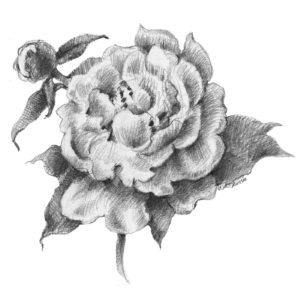July, King of Flowers
By Leslie Watkins
The botanical family Paeoniaceae contains just one genus; paeony or peonies, with over thirty species and more than a thousand named cultivars. These glorious blooms are large, extravagant, fragrant, long-lived and make wonderful cut flowers, if you can bear to cut them. They symbolize good fortune, a happy life and happy marriage. A beautiful bouquet of peonies will transform your home into an elegant abode.

Illustration by Leslie Watkins © 2018
Peonies are herbaceous perennials. They die back each year and remain dormant throughout winter. They emerge again in spring with distinctive deep red shoots. As the days warm up they quickly grow tall, strong stems that benefit from the support of hoops. Among the longest lived of perennials, they can live for a hundred years to be enjoyed by future generations of flower lovers.
It’s important to select a good location for your planting. Peonies grow best in loose, fertile, well drained soil with plenty of sun. They are hardy to zone three, relatively maintenance free and are not bothered by pests. Prepare a generous hole, 12 inches deep, with plenty of compost where they can grow undisturbed. Plant the eyes about two to three inches deep, on three-foot centers. They can grow three to four feet tall and may be used to create a low hedge. The best time to plant them is in the fall, as spring planted peonies may not bloom until the following year. Give them a couple of years to get established and then expect a lifetime of enjoyment.
You may notice ants on your peonies. They share a symbiotic relationship; the ants collect the sugary nectar in exchange for protecting the plants from damaging pests. Some say ants may help the blooms to open by climbing inside the buds and loosening them. Peonies are deer resistant.
Peony buds are ready to cut for the vase when they begin to open, about the size of a ping pong ball. They will continue to open in the vase. They may also be stored in refrigerators to delay bloom time. Remove only about a third of the leaves from each plant to ensure plenty of food reserves. The flowers look great in arrangements by themselves or in mixed bouquets with early green hydrangeas, hellebores and Solomon’s Seal.
Peonies are originally from China where they were regarded as the King of Flowers, over 2,000 years ago. They are used medicinally for headache, asthma, and childbirth pain. White peony root tea is used for night sweats, during pregnancy, and for hemorrhages. The petals may be parboiled and sweetened to be used in drinks, salads and as garnishes. In China and Europe, peony roots are used traditionally for their antispasmodic qualities, to relieve epilepsy, spasms, and various nervous afflictions.
In Greek mythology, Leto, the goddess of fertility told Paeon, physician to the gods, of a special root growing upon the slopes of Mt. Olympus. Paeon used the root to alleviate the pain of women in childbirth. Paeon’s teacher Asclepius, in a jealous rage of Paeon’s success, attempted to kill him. Zeus intervened and turned Paeon into a beautiful peony flower so he could continue to provide women with pain relief. Old texts state that women in ancient Greece used the seeds medicinally.
A-Z Direct Sow Seeds
- Amaranth
- Beans
- Carrots
- Chard
- Cucumber
- Kohlrabi
- Pumpkins
- Radish
- Squash
- Zucchini
